Pictures of buildings mentioned in the second edition “Suffolk” volume of “The Buildings of England” series by Sir Nikolaus Pevsner.
Little Wenham is a Suffolk hamlet, about 8 miles from Ipswich. It is not served by public roads but fortunately has some rights of way for access by foot. Only the exterior of the church is publicly accessible. The Tudor barn is fully visible. The hall and houses are on private land and most of the photographs that follow result from a visit by the Suffolk Institute of Archeology and History with the kind permission of the owners.
As there is no public access the most you can see is from the churchyard or the barn. This picture from my friend Peter Willis shows what the ordinary visitor can see:
As there is no public access the most you can see is from the churchyard or the barn. This picture from my friend Peter Willis shows what the ordinary visitor can see:
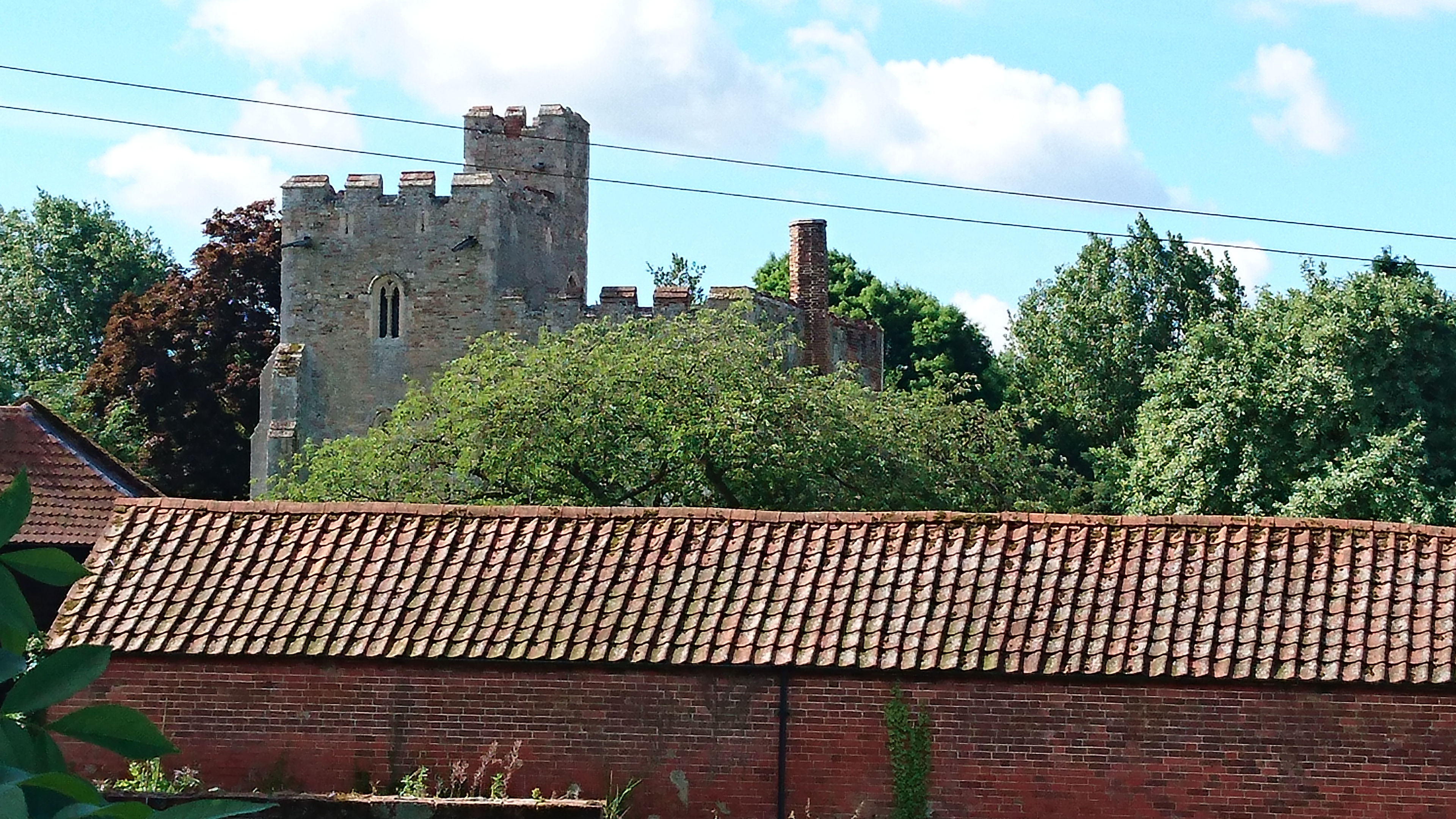
The layout of the church, the hall and the barn can be seen from this view from the door to the barn:
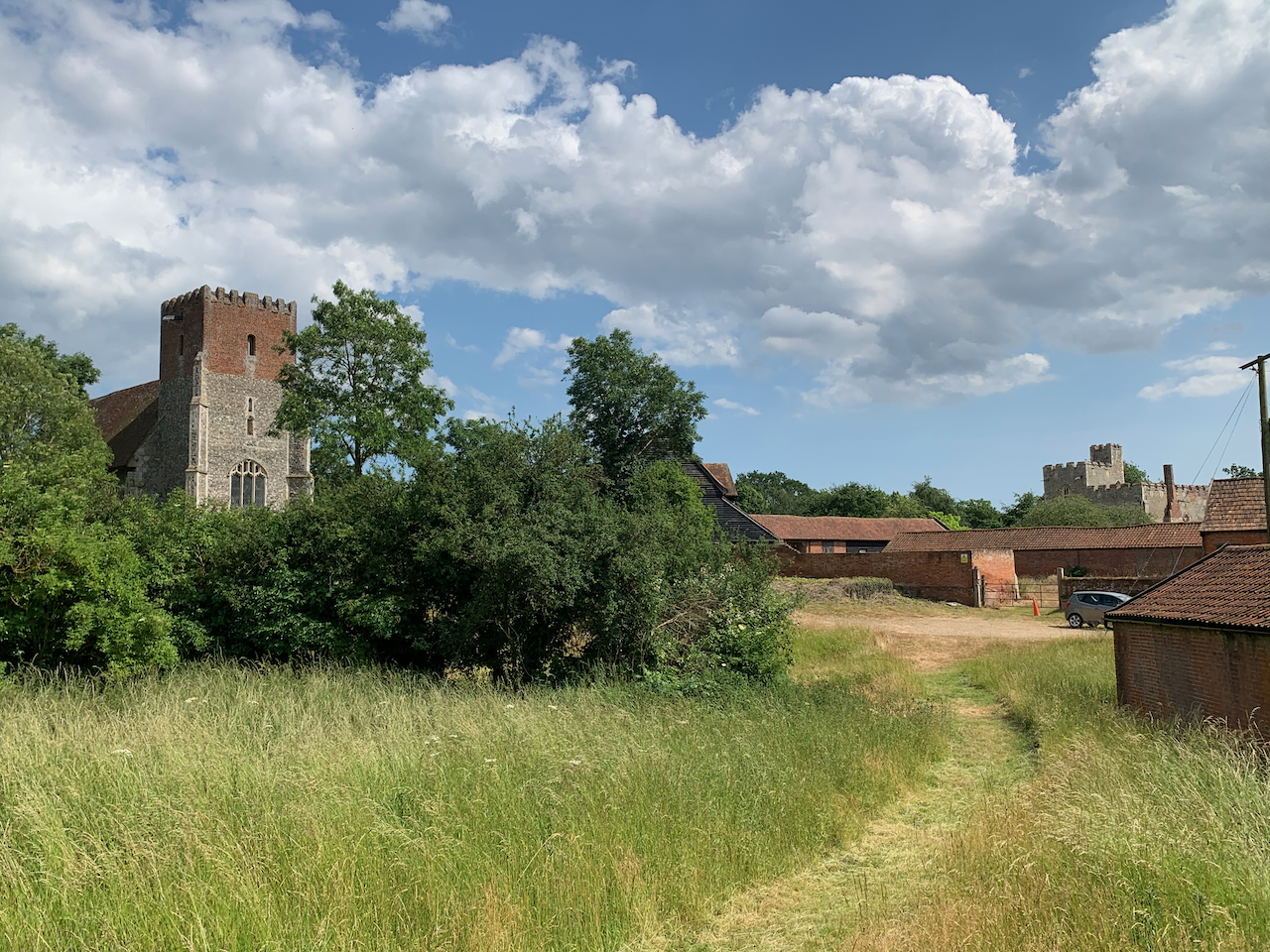
The Church is here:
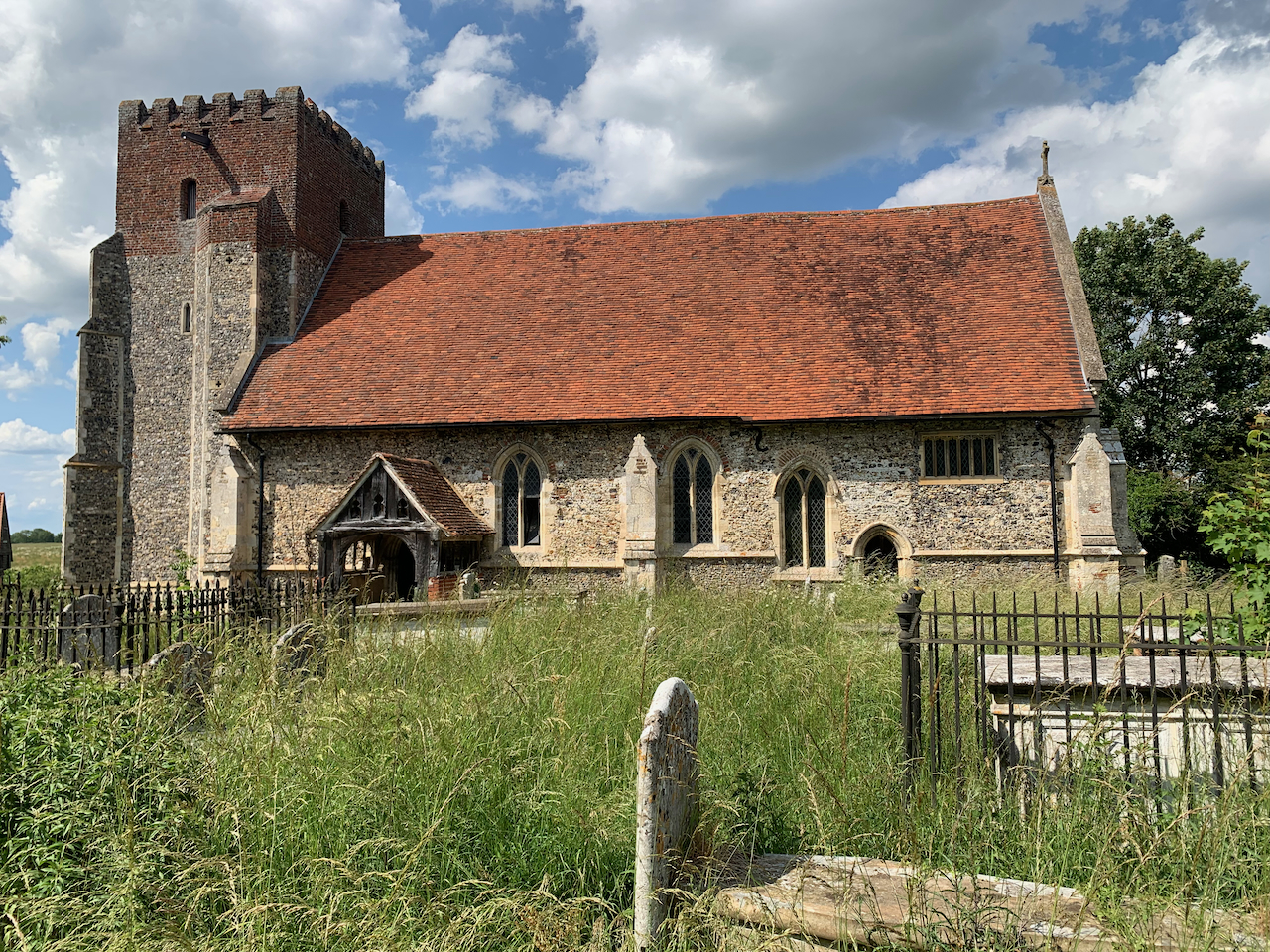
The barn is here:
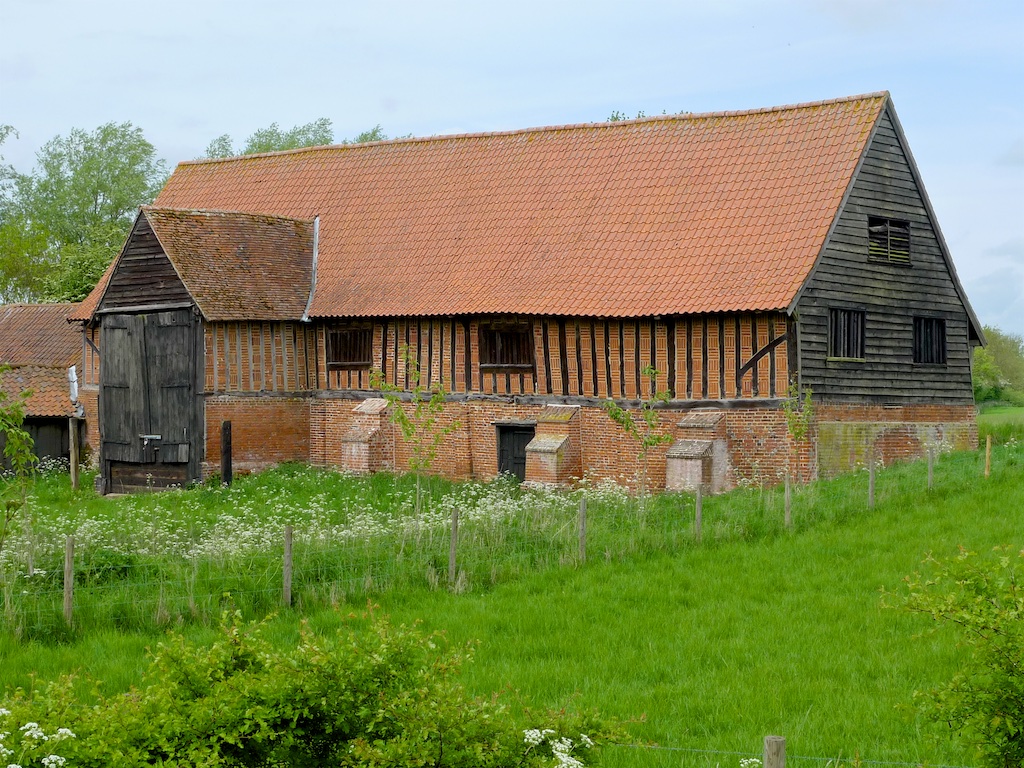
and the first view of the Hall is here, followed by some description before more pictures:
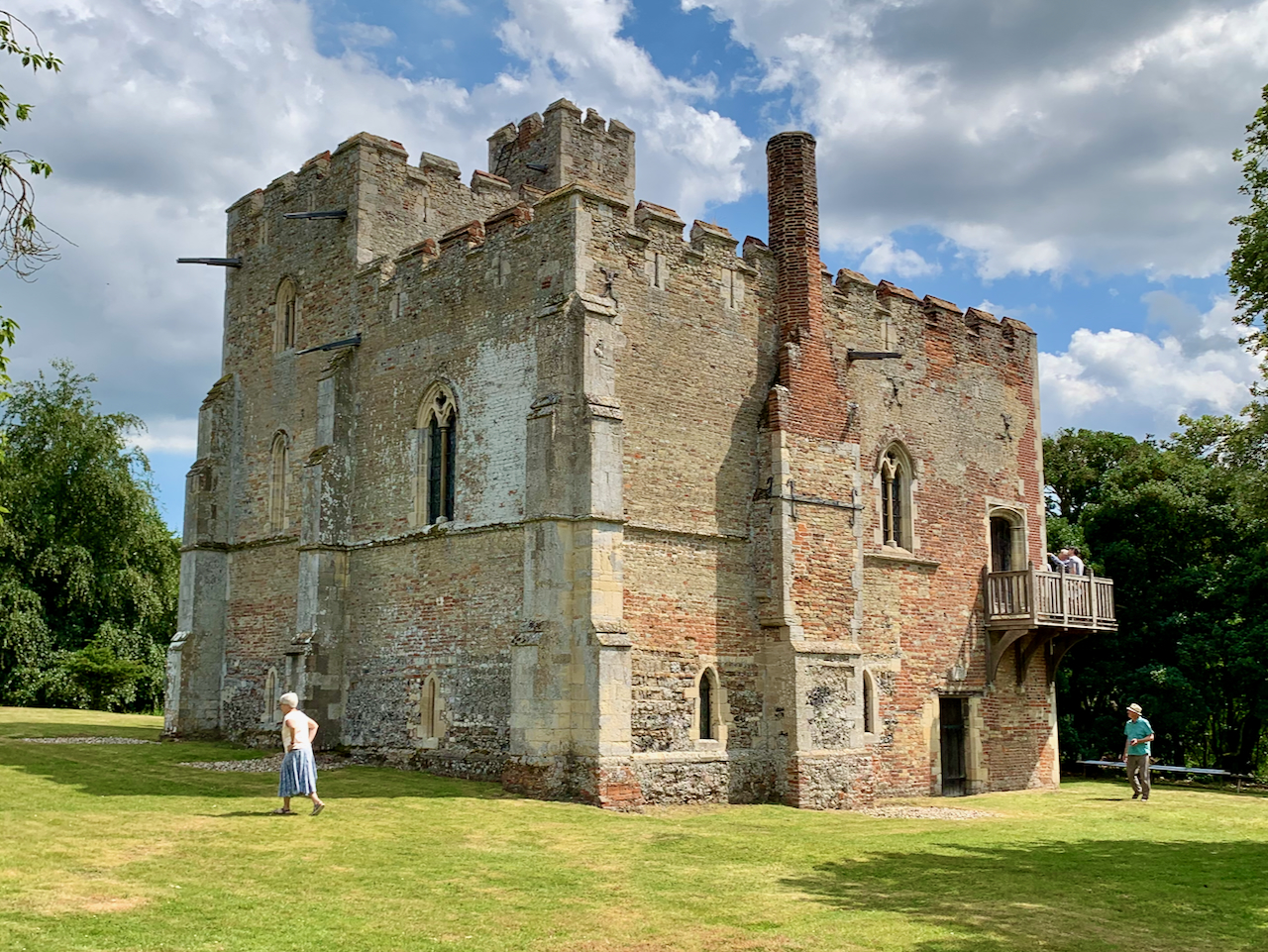
Pevsner describes Little Wenham Hall at length but there are changes between the first/second edition and the James Bettley (3rd - 2015) edition with the latter estimating its date as lying between 1270 and 1295. The latter edition is quoted here as further information has evolved over time:
“Little Wenham Hall (also known as Wenham Castle) is of great historical importance for two reasons. The first is that it is built of brick, and represents one of the earliest uses of home-made brick in England. Flint is used, with septaria, only for the base of the walls, and Caen stone for the much rebuilt buttresses and dressings. The character of the brickwork is charmingly crude, the bricks being of several sizes and colours, but predominantly yellow. The quantity of them indicated that they must have been made locally rather than imported from the Low Countries, although Flemish craftsmen may have been employed.
The second point of outstanding interest is that the house is a house and not a keep. It is fortified of course, but would not have been able to withstand any serious assault, and it is in its shape and appointment on the way from the fortress to the manor house and so ranks with Stokesay Castle and Acton Burnell (both Shropshire) of about the same date, as one of the incunabula of English domestic architecture.”
See also Polstead for early brick in a church.
(N.B. : incunabula = early development of a thing)
"The house is L-shaped with a spiral staircase in the re-entrant angle".
There is much more detail in Pevsner but one point is that it is generally thought that there was once a timber-framed annex providing access to the ground and first floors. The ground floor of what remains comprises an undercroft and a small room with the second floor having a large chamber and a chapel. There is a further small room above the chapel. This configuration led Pevsner to note, in the first and second editions only, that: “The roofs are embattled, and the different heights of hall range, chapel range, and stair turret create a picturesque skyline.” This was omitted from the Bettley edition, possibly because of conjecture that the hall was actually in the timber-framed annex.
Pevsner (Ed 2) also mentions Little Wenham Hall Farm of which he says “The house has a handsome C16 barn, timber-framed with brick-nogging and thatched roof”. The roof is no longer thatched as can be seen.
In Brick Building in England, by Jane A Wight (1972) she says “Once believed bricks must have been imported - via Ipswich, a major port - from Flanders. Certainly Flanders influence may be detected in small size of bricks, and Flemish craftsmen could have made them. (Flemings began to settle in East Anglia as early as C12, though peaks were later, in mid C14 and C15). Overwhelmingly probable that these yellow bricks were made of local comparatively chalky clay (gault). ... Important architecturally as well as for use of brick. ... Hall erected as house of a knight, not as a castle keep. ... Despite moat, thick walls - with more narrow lancets to ground floor - and battlements, essentially small dwelling. ... Protected but only battlements have any semblance of the aggressive (one recorded attack, though, took place during the Wars of Roses. Then owner, Gilbert Debenham, ‘Lord of Little Wenham’, was a notorious lawbreaker and extortioner. Debenhams had held manor from C14. Central boss of chapel vault represents St Petronilla, apocryphal ‘little daughter’ of St Peter. This dedication is extremely rare, but Whepsted Church (Suffolk) also has it. ... Brick sizes vary. ... Colours vary too. ... Remarkable survival, and a reproach to repeaters of the legend of dearth of mediaeval bricks brick in England.”
Sandon, in Suffolk Houses (1977, pp39/40) confirms the hypothesis of there being a timber-framed annex with speculation as to the functions of rooms across the brick and timber-framed sections.
“Little Wenham Hall (also known as Wenham Castle) is of great historical importance for two reasons. The first is that it is built of brick, and represents one of the earliest uses of home-made brick in England. Flint is used, with septaria, only for the base of the walls, and Caen stone for the much rebuilt buttresses and dressings. The character of the brickwork is charmingly crude, the bricks being of several sizes and colours, but predominantly yellow. The quantity of them indicated that they must have been made locally rather than imported from the Low Countries, although Flemish craftsmen may have been employed.
The second point of outstanding interest is that the house is a house and not a keep. It is fortified of course, but would not have been able to withstand any serious assault, and it is in its shape and appointment on the way from the fortress to the manor house and so ranks with Stokesay Castle and Acton Burnell (both Shropshire) of about the same date, as one of the incunabula of English domestic architecture.”
See also Polstead for early brick in a church.
(N.B. : incunabula = early development of a thing)
"The house is L-shaped with a spiral staircase in the re-entrant angle".
There is much more detail in Pevsner but one point is that it is generally thought that there was once a timber-framed annex providing access to the ground and first floors. The ground floor of what remains comprises an undercroft and a small room with the second floor having a large chamber and a chapel. There is a further small room above the chapel. This configuration led Pevsner to note, in the first and second editions only, that: “The roofs are embattled, and the different heights of hall range, chapel range, and stair turret create a picturesque skyline.” This was omitted from the Bettley edition, possibly because of conjecture that the hall was actually in the timber-framed annex.
Pevsner (Ed 2) also mentions Little Wenham Hall Farm of which he says “The house has a handsome C16 barn, timber-framed with brick-nogging and thatched roof”. The roof is no longer thatched as can be seen.
In Brick Building in England, by Jane A Wight (1972) she says “Once believed bricks must have been imported - via Ipswich, a major port - from Flanders. Certainly Flanders influence may be detected in small size of bricks, and Flemish craftsmen could have made them. (Flemings began to settle in East Anglia as early as C12, though peaks were later, in mid C14 and C15). Overwhelmingly probable that these yellow bricks were made of local comparatively chalky clay (gault). ... Important architecturally as well as for use of brick. ... Hall erected as house of a knight, not as a castle keep. ... Despite moat, thick walls - with more narrow lancets to ground floor - and battlements, essentially small dwelling. ... Protected but only battlements have any semblance of the aggressive (one recorded attack, though, took place during the Wars of Roses. Then owner, Gilbert Debenham, ‘Lord of Little Wenham’, was a notorious lawbreaker and extortioner. Debenhams had held manor from C14. Central boss of chapel vault represents St Petronilla, apocryphal ‘little daughter’ of St Peter. This dedication is extremely rare, but Whepsted Church (Suffolk) also has it. ... Brick sizes vary. ... Colours vary too. ... Remarkable survival, and a reproach to repeaters of the legend of dearth of mediaeval bricks brick in England.”
Sandon, in Suffolk Houses (1977, pp39/40) confirms the hypothesis of there being a timber-framed annex with speculation as to the functions of rooms across the brick and timber-framed sections.
Two further views follow, the second of which shows the L-shape and stair turret. The 3-storey section with a room on the ground floor has the chapel on the first floor (3-light windows) with a room above it.


The following picture shows the various doorways with the (modern) staircase indicating the likely position of the suggested timber-framed annex, which would have afforded access to the first door on the first floor, the other one around the corner possibly having an external staircase.

Some external features are two carved bricks, a general view of the bricks, and a stone over a door dated 1569 when alterations were made.



Some views of the interior:



.



Finally, for the Hall, the rib-vaulted roof of the chapel and the central boss with a crudely carved figure believed to be Saint Petronilla.


To finish, two interior views of the Tudor barn:

